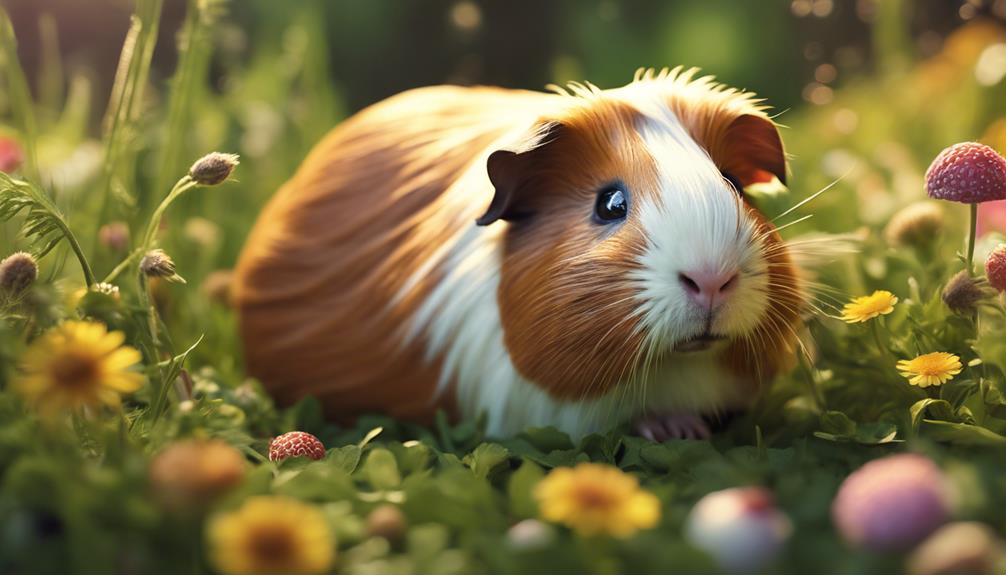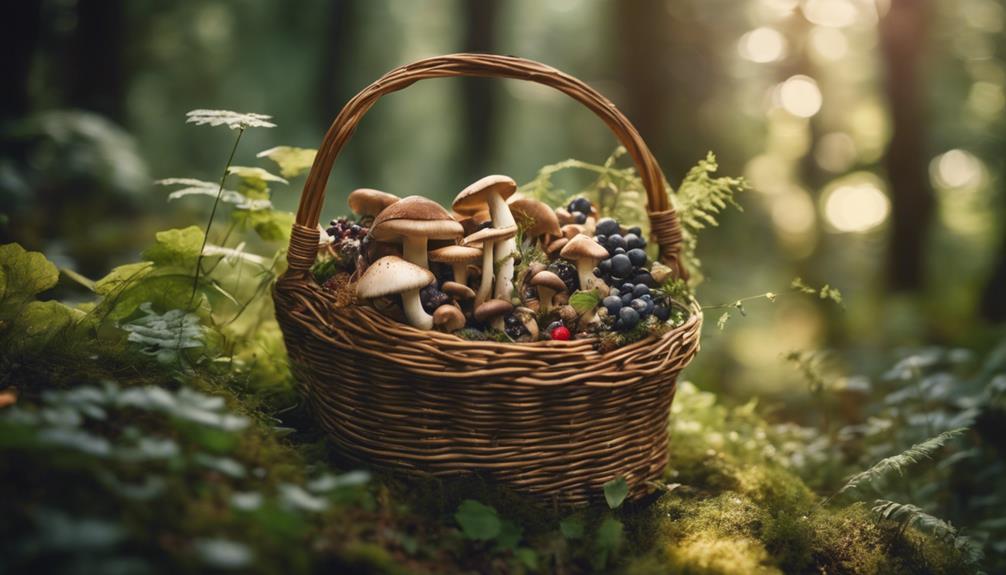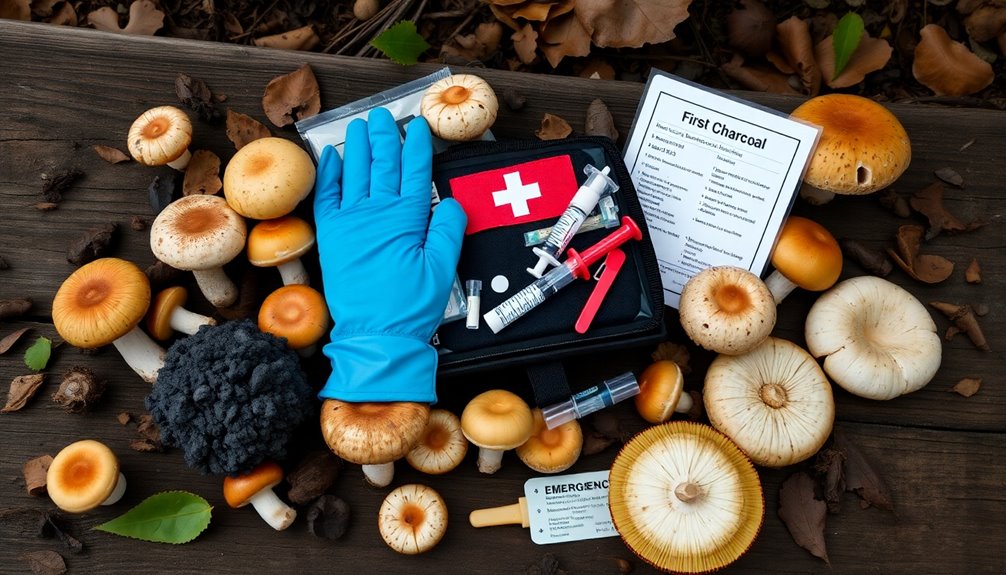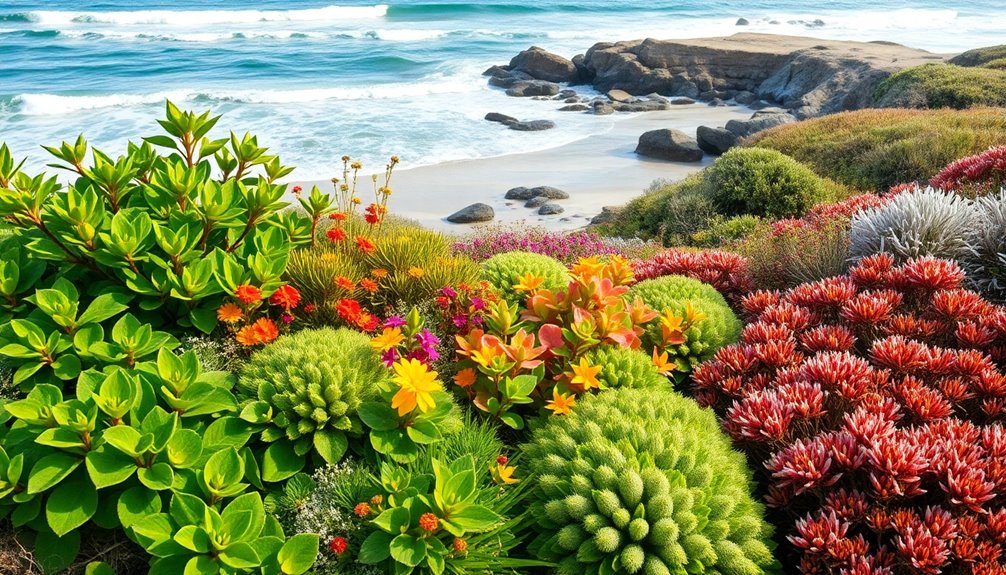You can forage for a variety of safe and nutritious plants to supplement your guinea pig's diet, including dandelions, clover, and wild raspberry leaves, which are rich in calcium, vitamin C, and fiber. These plants offer a range of essential nutrients important for a balanced diet. When foraging, accurately identifying plants is necessary to avoid toxic varieties and selecting young, healthy leaves for best nutrition. By foraging, you'll provide your guinea pig with fresh food variety, reducing stress and keeping them engaged. Now, discover more about the benefits, safety guidelines, and expert tips to access a world of safe and delicious foraged finds for your furry friend.
Key Takeaways
- Forage for safe and nutritious plants like dandelions, clover, and wild raspberry leaves that provide calcium, vitamin C, and fiber for guinea pigs.
- Accurately identify plants to avoid toxic varieties and choose young, healthy leaves for optimal nutrition.
- Explore meadows, parks, and woodlands for wild greens, prioritizing healthy plants and avoiding herbicide or pesticide-treated areas.
- Harvest responsibly by picking small amounts and maintaining a balanced feeding routine to promote sustainable foraging practices.
- Consult foraging guides and expert advice to ensure safe and varied foraged finds for your guinea pigs.
Weeds and Wild Plants Guide
What weeds and wild plants are safe and nutritious for your guinea pig to forage on? As a responsible guinea pig owner, it's important to know which plants are suitable for your pet to munch on. You'll be delighted to know that dandelions, clover, chickweed, plantain, and wild raspberry leaves are all safe and nutritious options for your guinea pig.
These plants provide essential nutrients like calcium, vitamin C, and fiber, making them an excellent addition to a balanced diet.
When foraging for your guinea pig, it's vital to accurately identify the plants to avoid toxic varieties. Choose young, healthy leaves for best nutrition.
You can forage in safe locations like parks, meadows, or even your own garden, which can offer a diverse range of fresh and nutritious options.
Benefits of Foraging for Guinea Pigs

As you explore the world of foraging for your guinea pigs, you'll discover that it offers a multitude of benefits for their health and well-being.
For one, foraging provides them with fresh food variety, which can help reduce stress levels and keep them engaged and interested in their diet.
Fresh Food Variety
By foraging, you can provide your guinea pigs with a diverse array of fresh foods that they'll love, including wild greens, fruits, and vegetation that are rich in essential vitamins and minerals. This variety is crucial for a well-rounded guinea pig's diet, as it guarantees they get the nutrients they need to thrive.
By incorporating foraged foods into their meals, you'll find that your guinea pigs will be more enthusiastic about mealtime, and their overall health will improve. You'll also find that foraging allows you to offer your guinea pigs a range of wild flavors and textures they won't find in store-bought veggies.
As you venture out to find fresh goodies, you'll discover that foraging is a great way to provide your guinea pigs with the nutrients they need, while also engaging them mentally and physically.
Reduced Stress Levels
Foraging activities can be a game-changer for your guinea pigs, providing a stimulating outlet for their natural curiosity and greatly reducing stress levels. By engaging in foraging activities, you can help your guinea pigs feel more relaxed and content. This is especially important for guinea pigs that have been rescued from shelters, as they may have experienced trauma or stress in their past.
Foraging for guinea pigs is an excellent way to provide mental stimulation and exercise, which can help reduce stress and anxiety. When you allow your guinea pigs to forage, they can engage their natural behaviors, such as sniffing, digging, and nibbling, which helps to reduce stress and boredom. Additionally, foraging provides an opportunity for your guinea pigs to find free food, such as fresh plants and herbs, which can add variety to their diet.
Where to Find Wild Greens

You'll find a treasure trove of wild greens in unexpected places, from the rolling hills of meadows and parks to the hidden gems of woodlands and urban areas.
As you venture out to forage for your guinea pigs, keep an eye out for hedgerows, fields, and areas near rivers, streams, and lakes. These spots often teem with a variety of wild plants perfect for your furry friends.
Don't overlook abandoned lots, cliff paths, or even your own garden – these can be goldmines for fresh, pesticide-free greens. When foraging, prioritize healthy plants and steer clear of areas treated with herbicides or pesticides.
Remember to respect public spaces and always follow local regulations. By exploring these places to find wild greens, you'll provide your guinea pigs with a diverse and nutritious diet rich in vitamins and minerals.
Happy foraging!
When to Go Foraging Safely

As you plan your foraging trips, consider the changing seasons to make sure you're gathering the freshest, safest options for your guinea pigs. Guinea pigs love variety, and the seasons offer a rotating selection of delicious and nutritious treats.
In the spring, take advantage of fresh growth and abundant vegetation. Summer brings a variety of edible weeds and plants for your guinea pigs to enjoy.
Autumn provides an array of nutritious forage options before plants start to wither. Even in winter, you can still find evergreen plants and certain winter weeds to add to their diet.
When planning your foraging trips, consider your local climate and weather conditions. Will the plants be more abundant in the spring or summer? Are there specific plants that thrive in your region during autumn?
Essential Foraging Tips and Rules

When venturing out to gather treats for your guinea pigs, remember that safety and responsibility are paramount, so it's important to follow essential guidelines. You'll want to research and accurately verify any foraged plants to make sure they're safe for your furry friends to munch on.
Avoid foraging in areas that may have been treated with herbicides or pesticides, as these can be toxic to your guinea pigs. When harvesting plants, do so responsibly by picking only small amounts and avoiding uprooting, which promotes sustainability. Opt for public spaces with healthy plants, and be respectful of the environment.
When introducing foraged plants into your guinea pigs' diet, follow guidelines to maintain a balanced and nutritious feeding routine. By following these essential foraging tips and rules, you'll be able to provide your guinea pigs with delicious and safe treats while promoting a sustainable and environmentally friendly foraging practice.
Foraging Equipment You'll Need

Before heading out to gather fresh treats for your guinea pigs, equip yourself with the right gear to guarantee a safe and successful foraging experience. Having the proper tools will assure you can harvest wild herbs and other plants efficiently, while also keeping you and your guinea pigs safe.
Here are the essential items you'll need:
- Scissors or secateurs: For harvesting plants safely and efficiently.
- Protective gloves: To safeguard your hands from thorns, prickles, and potential allergens.
- Foraging bag or basket: To collect and organize your finds, making it easier to transport them back home.
Additionally, consider bringing plastic bags to store your foraged plants in hot weather. This will help maintain their freshness and prevent wilting or spoilage before feeding them to your guinea pigs.
Identifying Safe and Toxic Plants

To guarantee a safe foraging experience for your guinea pig, it's crucial to know which plants are safe and which ones to avoid.
You'll need to recognize the differences between toxic plants like hemlock and buttercup, and safe options like dandelions and clover.
Toxic Plants to Avoid
When looking for treats for your guinea pig, it's crucial to identify and avoid toxic plants that can cause harm or even be fatal to your pet. Guinea pigs are sensitive creatures, and ingesting toxic plants can lead to serious health issues, including digestive problems, organ damage, and even death.
Here are three common toxic plants to avoid:
- Hemlock: A highly toxic plant that can cause respiratory failure and death in guinea pigs.
- Foxglove: Contains a toxic compound called digoxin, which can be fatal to guinea pigs if ingested.
- Buttercup: Contains toxic compounds that can cause digestive problems, vomiting, and diarrhea in guinea pigs.
Recognizing Safe Options
When foraging for treats for your guinea pig, you'll need to recognize and choose safe options that are both nutritious and harmless. As you venture out to find edible weeds and plants, it's important to identify the right ones. Look for common edible weeds like dandelions, clover, plantain, and chickweed, which are all safe for your guinea pigs to munch on. These plants are rich in nutrients and can be a great addition to their food.
When researching, consult foraging guides and seek expert advice to make sure you're picking the right plants. Pay attention to distinct features, such as the yellow flowers and toothed leaves of dandelions. By doing so, you'll be able to provide your guinea pigs with a varied and healthy diet.
Feeding Foraged Finds to Guinea Pigs

You can start introducing foraged finds like dandelions, clover, and wild strawberries into your guinea pig's diet in moderation, typically 1-2 tablespoons per pound of body weight daily. This will provide essential nutrients, vitamins, and minerals for their overall health.
When incorporating foraged finds, remember to:
- Offer variety: Mix and match different foraged plants to mimic their natural diet and promote overall well-being.
- Make it fresh: Guarantee the foraged finds are fresh and free of pesticides or other harmful substances.
- Consult a vet: Before making any changes to your guinea pig's diet, speak with a veterinarian to ensure you're providing the best possible nutrition.
Additionally, consider using sow thistle to make a vitamin C-rich tea as a nutritious treat for your guinea pig. By introducing foraged finds into their diet, you'll not only provide a cost-effective and nutritious option but also add enrichment to their daily routine. Just remember to prioritize their safety by avoiding toxic plants and ensuring proper identification.
Frequently Asked Questions
What Is a Safe Forage for Guinea Pigs?
You're wondering what's a safe forage for your guinea pigs? Look for wild plants like dandelions, clover, chickweed, and plantain that are free from pesticides and toxins, and make sure you properly identify them to keep your pets healthy and happy! Before introducing any new plants into your guinea pigs’ diet, it’s important to start with small amounts and monitor them for any adverse reactions. Additionally, always wash the wild plants safe for guinea pigs to remove any dirt or potential contaminants. Providing a variety of these natural forages will not only enrich their diet but also keep them engaged and happy.
What Is Tasty Food for Guinea Pigs?
As you step into the lush outdoors, imagine your guinea pig's delight in savoring juicy wild raspberries, sweet wild strawberries, and tangy dandelion greens – all tasty treats that'll make their whiskers twitch with joy!
What Is the Safest Food for Guinea Pigs?
You're wondering what the safest food for your guinea pig is. Fresh, pesticide-free greens like dandelions, clover, and plantain are great options, but avoid toxic plants and high-sugar, high-salt, or high-fat foods to keep them healthy.
How to Make Guinea Pig Forage?
You're creating a guinea pig forage area! Scatter safe plants like dandelions and clover in a clean space, monitor their eating, rotate plants regularly, and introduce new items gradually to keep them engaged and safe.
Conclusion
You've now opened the world of foraging for your guinea pigs, and it's time to get started!
Did you know that guinea pigs can eat up to 80% of their diet in fresh veggies and fruits?
By foraging for wild greens, you'll not only provide your pets with a nutritious diet but also reduce your environmental paw-print.
Remember to always prioritize safety and identification when foraging, and happy snacking!










